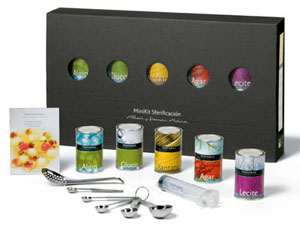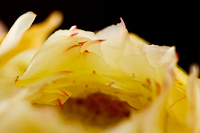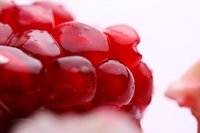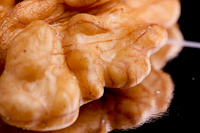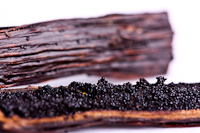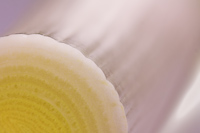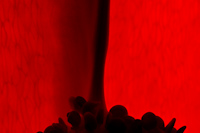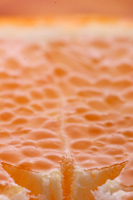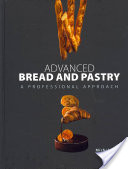Butter poached and seared scallops with mango-tomato terrine, hazelnuts, “salami salt” and balsamic vinegar
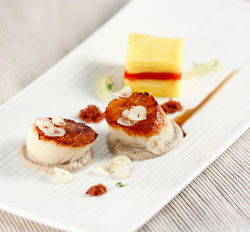
Scallops are without doubt some of my favourites when it comes to seafood. You can praise clams, octopus, prawns, periwinkles or flying-fish roe all you want - but a pair of perfectly cooked scallops are irresistible - be it on a restaurant menu or at home.
Their amazingly sweet taste and ever so slight saltiness together with their soft, tender meat structure (if not over-cooked!) makes them seem almost heaven-sent. There must be a thousand good recipes for scallops around, but a good place to start is simple pan-seared ones, in a non-stick skillet on fairly high heat, which gives that nice golden caramelized crust before they, heaven forbid, overcook!
Other ways might be gratinated scallops, grilled or as a ceviche.
I started off by making a mango and tomato terrine, thin slices of ripe, sweet mango and some tomato “confit”. For the tomatoes, peel a couple of tomatoes and cut them into petals. Season with orange peel, thyme, black pepper, cloves, a pinch of salt and a good sprinkle of sugar. Arrange on a baking sheet and pour a couple of drops of olive oil on top. Let dry out in the oven @ 120 degrees C for a good hour and a half. Then find a nice small terrine mold and line it with plastic wrap. Then pass the mango slices and the tomatoes in a lukewarm syrup with gelatine and arrange in the terrine mold. Try not to get any air pockets and the other important thing is to let it cool under pressure. If you have a heavy object that fits perfectly into your terrine mold, GOOD! If not, then just keep building your terrin so that it rises well over the edge of the mold and then fold in the plastic wrap on top and press down with a heavy flat object. Leave in the fridge for minimum a couple of hours to set.
The scallops sit on a pillow of hazelnut puree. Boil hazelnuts in 2 parts milk and 1 part cream, covered, over very low heat for 1 hour. Mix the hazelnuts for about 5 minutes in a blender, adding the cooking liquid as needed to make a nice smooth puree. Add a pinch of salt and a pinch of sugar.
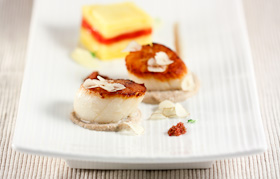
“Salami salt” - a flavorful salty powder to be used instead of normal salt. Take a piece of your favourite air dried salami, dice it finely and put it in a non-stick pan over low heat. Leave it frying there, stirring from time to time, until the dices becomes really hard and crispy. Let them cool down before you pass them through the blender to make a fine powder. It might be nessecary to blend them, then return the powder to the pan to let it dry out a bit more, before you let it have a final spin in the blender. This way you should end up with a fine powder packed with taste.
The scallops themselves were first poached in a “beurre monté” at low temperature for around 5 minutes and then quickly seared in a hot skillet and only seasoned with a pinch of salt.
Only thing left to add would be a couple of drops of a good aged balsamic vinegar - a thick black syrup wih a modest acidic punch.
Here´s some tips on cooking great scallops at home:
1. Frozen scallops are cheaper than fresh-caught scallops, but the frozen ones contains more water and will release a lot of liquid as they defrost. Make sure to get rid of this released liquid BEFORE the scallops go in the skillet, otherwise you will end up with steamed ones. If using frozen ones, thaw them slowly in the refrigerator overnight, sitting on plate lined with paper towels.
The fresh ones should have a nice sweet and briny smell, not fishy. If they seem too old, go for the frozen ones.
2. Scallops are not white, ideally they should have a color somewhere between beige cream and pale pink. The frozen ones unfortunately, are usually quite white, which means they contain more water and/or chemicals.
3. Make sure the scallops have a dry surface before cooking them. Do this by patting them dry with paper towels just before searing them.
4. Do not cook to many scallops at a time in the pan. This is even more important when cooking the frozen variety. Also make sure the pan is hot before you put the scallops in there.
5. DO NOT OVERCOOK THE SCALLOPS! Too long in the pan and they turn into a horrible rubber ball - worse than overcooked chicken breast. Instead leave them, when cut open, still translucent in the center.
Enjoy!
Capesante affogati in burro e scottate. Terrina di mango e pomodori, nocciole, “sale salame” ed aceto balsamico
Le capesante sono senza dubbio alcuni dei miei preferiti frutti di mare. Si può lodare le vongole, polpo, scampi, Littorina littorea o uova di pesce volante, però un paio di capesante cotte a perfezione sono irresistibili - sia sul menu del ristorante come a casa.
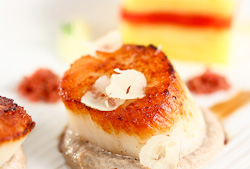 Il loro sapore dolce e la lieve salinità insieme a la carne tenera (se non troppo cotta!) li fa sembrare una cosa divina. Ci sono sicuramente mille ricette buone per capesante, ma un buon punto di partenza sarebbe - le capesante scottate, in una padella antiaderente a fuoco abbastanza alto, che dà quella bella crosta dorata caramellata prima che, attenzione, si scuoce! Se no, ci sono sempre le capesante gratinate, alla griglia, crude o come un ceviche.
Il loro sapore dolce e la lieve salinità insieme a la carne tenera (se non troppo cotta!) li fa sembrare una cosa divina. Ci sono sicuramente mille ricette buone per capesante, ma un buon punto di partenza sarebbe - le capesante scottate, in una padella antiaderente a fuoco abbastanza alto, che dà quella bella crosta dorata caramellata prima che, attenzione, si scuoce! Se no, ci sono sempre le capesante gratinate, alla griglia, crude o come un ceviche.
Ho fatto una terrina di mango e pomodoro, fette sottili di mango maturo e di pomodori “confit”. Per i pomodori, spellare un paio di pomodori e tagliarli a petali. Condire con buccia d’arancia, timo, pepe nero, chiodi di garofano, un pizzico di sale e una bella spolverata di zucchero. Sistemare su una teglia da forno e aggiungere un filo d´olio di oliva. Lasciare asciugare in forno a 120 ° C per un´ora e mezza. Poi tocca trovare uno stampo piccolo da terrina. Foderare lo stampo con pellicola. Passare le fette di mango e pomodoro in uno sciroppo tiepido con gelatina e disporre nello stampo. Cercare di evitare bolle d’aria. L’altra cosa importante è farlo raffreddare sotto pressione. Se disponete di un oggetto pesante che si inserisce perfettamente nel vostro stampo da terrina, bene! Se no, continuare a aggiungere i strati della terrina oltre il bordo dello stampo e poi piegare la pellicola sulla parte superiore. Mettere sotto pressione di un oggetto pesante. Lasciare in frigo per almeno un paio d’ore.
Le capesante sono appoggiati su un cuscino di purea di nocciole. Lessare le nocciole in una pentola con 2 parti di latte e 1 parte di panna, coperti, a fuoco molto basso per 1 ora. Frullare le nocciole per circa 5 minuti in un frullatore, aggiungere il liquido di cottura mano a mano, quanto basta per fare una purea liscia. Aggiungere un pizzico di sale e un pizzico di zucchero.
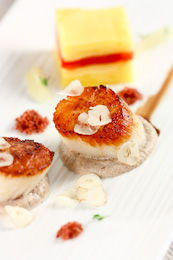 “Sale di salame” - una polvere saporito, utilizzato al posto del sale normale. Prendere un pezzo del vostro salame preferito, tagliare a dadi piccoli e metterli in una padella antiaderente a fuoco basso. Lasciarli friggere, mescolando di tanto in tanto, finchè i dadi non diventano duri e croccanti. Lasciarli raffreddare prima di passarli nel frullatore per fare una polvere finissima. Può darsi che tocca ripassare la polvere in padella per farla asciugare ancora. Il risultato sarà una polvere fina piena di sapore.
“Sale di salame” - una polvere saporito, utilizzato al posto del sale normale. Prendere un pezzo del vostro salame preferito, tagliare a dadi piccoli e metterli in una padella antiaderente a fuoco basso. Lasciarli friggere, mescolando di tanto in tanto, finchè i dadi non diventano duri e croccanti. Lasciarli raffreddare prima di passarli nel frullatore per fare una polvere finissima. Può darsi che tocca ripassare la polvere in padella per farla asciugare ancora. Il risultato sarà una polvere fina piena di sapore.
Le capesante sono stati affogati in un “beurre monté” a bassa temperatura per circa 5 minuti e poi velocemente scottate in una padella calda e condite soltanto con un pizzico di sale.
Finalmente manca solo qualche goccia di un buon aceto balsamico.
Ecco alcuni suggerimenti su come cucinare perfette capesante a casa:
1. Le capesante surgelate costano di meno rispetto a capesante fresche, ma quelli congelati contiene più acqua e tira fuori un sacco di liquido quando si scongela. Assicurarsi di avere tolto questo liquido prima che le capesante vanno in padella, altrimenti finirà con capesante cotte al vapore. Se si usano quelli surgelati, scongelare lentamente in frigorifero per una notte, messi su un piatto con carta di cucina.
Le capesante freschi dovrebbero avere un buon profumo dolce e salmastro, non di pesce. Se sembrano troppo vecchi, scegliere quelli congelati.
2. Capesante non sono di colore bianco, piuttosto tra il beige o crema e rosa pallido. Quelli congelati, purtroppo, sono di solito abbastanza bianchi, significa che contengono un bel po di acqua e / o prodotti chimici.
3. Assicurarsi che le capesante hanno una superficie asciutta prima di cuocerli. Asciugarli sempre con un po di carta di cucina appena prima di metterli in padella.
4. Non mettere troppe capesante nella padella allo stesso tempo. Questo è ancora più importante quando si cucina quelli congelati. Controllare inoltre che la padella è calda prima di mettere le capesante.
5. NON stracuocere le capesante! Troppo tempo nella padella e si trasformano in delle palle di gomma orribile. Anzi, lasciarli ancora leggermente traslucidi nel centro.
Buon appetito!
